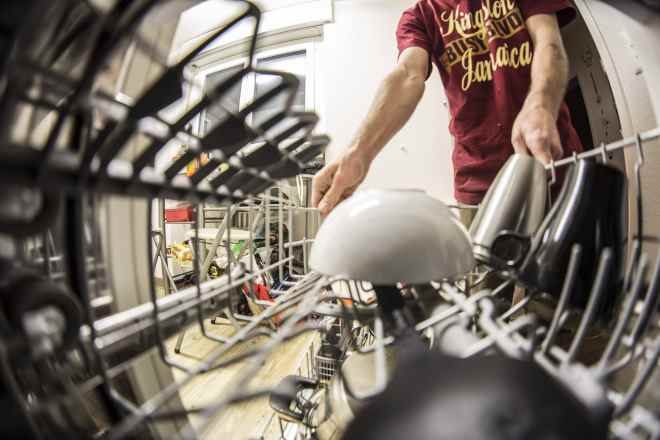How Dishwashers Work and Why They Help in Everyday Life
Dishwashers are machines that clean dishes automatically. They use water, soap, and spinning jets to wash plates, cups, and other utensils. Learning how they work can help understand how they make kitchen chores easier and save time in daily routines.

What is an automatic dishwasher and how does it function?
An automatic dishwasher is a kitchen appliance designed to clean dishes, utensils, and cookware without manual scrubbing. The machine operates by spraying hot water and detergent onto the dirty items, effectively removing food particles and grease. The dishwasher’s interior is typically divided into two racks: an upper rack for glasses, cups, and smaller items, and a lower rack for plates, pots, and larger dishes.
The dishwashing process begins when you load the machine, add detergent, and select a cleaning cycle. Once started, the dishwasher fills with water, heats it to the appropriate temperature, and activates a pump that circulates the water through spray arms. These spray arms rotate, directing jets of water and detergent onto the dishes from multiple angles. After the main wash cycle, the dishwasher drains the dirty water and initiates one or more rinse cycles with clean water to remove any remaining detergent or food particles.
What are the key components of a dishwasher?
Understanding the main components of a dishwasher can help users troubleshoot issues and maintain their appliance effectively. The key elements of a dishwasher include:
-
Water inlet valve: Controls the flow of water into the dishwasher.
-
Heating element: Warms the water for more effective cleaning and drying.
-
Pump: Circulates water through the spray arms and drains dirty water.
-
Spray arms: Distribute water and detergent throughout the dishwasher.
-
Filters: Trap food particles to prevent them from recirculating onto clean dishes.
-
Control panel: Allows users to select cycles and options.
-
Door seal: Prevents water from leaking during operation.
How do dishwashers contribute to water and energy efficiency?
Contrary to popular belief, dishwashers can be more water and energy-efficient than washing dishes by hand. Modern dishwashers are designed to use less water and electricity while still delivering excellent cleaning results. Energy Star certified dishwashers, for example, use advanced technology to minimize water and energy consumption without compromising performance.
Dishwashers achieve water efficiency by recirculating water throughout the wash cycle, rather than continuously using fresh water. This process allows them to clean a full load of dishes using significantly less water than washing the same amount by hand. Additionally, the ability to heat water internally means dishwashers can use hotter water temperatures more efficiently than handwashing, resulting in better sanitization and grease removal.
What are the benefits of using a dishwasher in everyday life?
Incorporating a dishwasher into your daily routine can offer numerous advantages:
-
Time-saving: Dishwashers automate the cleaning process, freeing up time for other activities.
-
Consistency: They provide reliable cleaning results with each cycle.
-
Sanitization: Higher water temperatures effectively kill more bacteria than handwashing.
-
Water conservation: Modern dishwashers typically use less water than washing dishes by hand.
-
Energy efficiency: Many dishwashers are designed to minimize electricity consumption.
-
Convenience: Loading a dishwasher is often easier and quicker than washing dishes manually.
-
Reduced wear on hands: Less exposure to hot water and harsh detergents protects your skin.
How can users maximize their dishwasher’s performance?
To get the most out of your dishwasher and ensure optimal cleaning results, consider the following tips:
-
Scrape plates before loading to remove large food particles.
-
Load dishes properly, avoiding overcrowding and ensuring spray arms can rotate freely.
-
Use the appropriate amount and type of detergent recommended for your machine.
-
Clean the filters regularly to maintain efficiency and prevent odors.
-
Run full loads when possible to maximize water and energy efficiency.
-
Choose the right cycle for your dishes and level of soiling.
-
Use rinse aid to improve drying performance and prevent water spots.
What are the different types of dishwashers available?
When considering a dishwasher for your home, it’s important to understand the various types available to choose the one that best fits your needs and kitchen layout. Here’s an overview of common dishwasher types:
| Type | Description | Key Features |
|---|---|---|
| Built-in | Standard full-size dishwasher integrated into kitchen cabinetry | Large capacity, variety of cycle options |
| Portable | Freestanding unit that can be rolled to the sink when needed | Flexibility for renters or small kitchens |
| Drawer | One or two pull-out drawers that operate independently | Energy-efficient for small loads, ergonomic design |
| Countertop | Compact units that sit on the countertop | Ideal for small apartments or RVs |
| Integrated | Fully concealed behind a cabinet panel to match kitchen decor | Seamless appearance, high-end option |
Prices, rates, or cost estimates mentioned in this article are based on the latest available information but may change over time. Independent research is advised before making financial decisions.
In conclusion, dishwashers have become an essential kitchen appliance, offering convenience, efficiency, and effective cleaning. By understanding how dishwashers work and their various features, homeowners can make informed decisions about incorporating these appliances into their daily lives, potentially saving time, water, and energy in the process.




